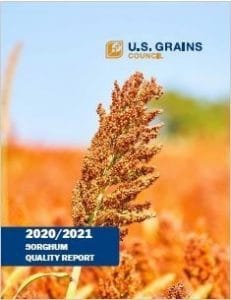 The U.S. Grains Council (USGC) has published its 2020/2021 Sorghum Quality Report and, for the second year in a row, the average grade was above the necessary requirements for U.S. No. 1 sorghum.
The U.S. Grains Council (USGC) has published its 2020/2021 Sorghum Quality Report and, for the second year in a row, the average grade was above the necessary requirements for U.S. No. 1 sorghum.
Protein content in sorghum was up eight percent year over year, with readings coming in at 11.2 percent, almost a full percentage point jump above last year’s content.
“Protein content in sorghum is really what can set it apart from other coarse grains,” said Reece Cannady, USGC manager of global trade. “When evaluating sorghum in animal diets, it’s important to consider the value of this protein, particularly when every percentage point of protein is so precious with rapidly rising costs.”
The report, funded through the U.S. Department of Agriculture’s Foreign Agricultural Service (USDA’s FAS) Agricultural Trade Promotion (ATP) program, provides international customers and other interested parties accurate, unbiased information about the 2020 U.S. sorghum crop.
A total of 108 samples were collected between September 2020 and February 2021 from 13 participating elevators in Texas, Kansas, Nebraska and South Dakota. Scientists at Texas A&M University’s Cereal Quality Lab and at the Amarillo Grain Exchange calculated averages and standard deviations for each quality factor tested and reported results for the U.S aggregate.
Total sorghum damage came in at just 0.0 percent in the aggregate, and broken kernel and foreign material (BNFM) was only 1.6 percent, both similar to last year’s results, highlighting how hard the grain is and how well it holds up during handling and storage.
For the second year in a row, 100 percent of the samples tested undetectable for tannins.
“A common misconception is that if sorghum is red, it has tannins in it, since that is the case in other major sorghum-producing regions like Argentina, Africa and Australia,” Cannady said. “But, in the United States, we grow a non-tannin red variety. Nutrient absorption can be problematic with high-tannin varieties, essentially depleting the value of the grain, so using a low-tannin, U.S.-grown seed yields great results in animal diets.”
This report is the third since the first sorghum report that covered the 2016/2017 crop. The Council plans to share the report virtually around the world and will also present the information during a sorghum conference for the Chinese market in the near future.
“This report is helping fulfill the Council’s mission to provide the latest information for end-users around the world interested in understanding how U.S. sorghum differs from other varieties,” Cannady said. “We hope the 2020/2021 Sorghum Quality Report provides valuable information about the quality of U.S. sorghum and shows our valued trade partners that the United States is a trusted supplier.”
Read the full 2020/2021 Sorghum Quality Report.
About The U.S. Grains Council
The U.S. Grains Council develops export markets for U.S. barley, corn, sorghum and related products including distiller’s dried grains with solubles (DDGS) and ethanol. With full-time presence in 28 locations, the Council operates programs in more than 50 countries and the European Union. The Council believes exports are vital to global economic development and to U.S. agriculture’s profitability. Detailed information about the Council and its programs is online at www.grains.org.
